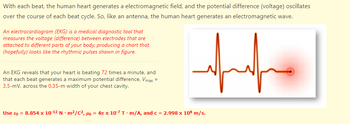Question

Transcribed Image Text:With each beat, the human heart generates a electromagnetic field, and the potential difference (voltage) oscillates
over the course of each beat cycle. So, like an antenna, the human heart generates an electromagnetic wave.
An electrocardiogram (EKG) is a medical diagnostic tool that
measures the voltage (difference) between electrodes that are
attached to different parts of your body, producing a chart that
(hopefully) looks like the rhythmic pulses shown in figure.
An EKG reveals that your heart is beating 72 times a minute, and
that each beat generates a maximum potential difference, Vmax =
3.5-mV, across the 0.35-m width of your chest cavity.
Use &o = 8.854 x 10-12 Nm²/C², Ho = 4 x 10-7 Tm/A, and c = 2.998 x 108 m/s.
![Determine the following for the EM wave generated during each beat cycle of your heart.
(a) Find the frequency and period of each heart beat.
Hz
f =
T =
S
(b) Find the wavelength of the EM wave produced by your beating heart.
λ =
PopUp: Period and Frequency
m
(c) What is the peak strength of the electric field between the two electrodes?
Emax =
]mV/m
Erms
Brms =
(d) Determine the maximum strength of the corresponding magnetic field.
Bmax =
T
(e) Calculate the rms average values of the electric and magnetic field strengths.
mV/m
T
PopUp: RMS Averages](https://content.bartleby.com/qna-images/question/c9cc212e-530e-418e-a717-3da751b9b16b/77169ac7-13db-4188-a384-cf8bfb443629/2kd8x8i_thumbnail.png)
Transcribed Image Text:Determine the following for the EM wave generated during each beat cycle of your heart.
(a) Find the frequency and period of each heart beat.
Hz
f =
T =
S
(b) Find the wavelength of the EM wave produced by your beating heart.
λ =
PopUp: Period and Frequency
m
(c) What is the peak strength of the electric field between the two electrodes?
Emax =
]mV/m
Erms
Brms =
(d) Determine the maximum strength of the corresponding magnetic field.
Bmax =
T
(e) Calculate the rms average values of the electric and magnetic field strengths.
mV/m
T
PopUp: RMS Averages
Expert Solution
This question has been solved!
Explore an expertly crafted, step-by-step solution for a thorough understanding of key concepts.
Step by stepSolved in 3 steps with 2 images

Knowledge Booster
Similar questions
- At some instant and location, the electric field associated with an electromagnetic wave in vacuum has the strength 97.9 V/m. Find the magnetic field strength ?, the total energy density ?, and the power flow per unit area, all at the same instant and location. ?= T ?= J/m3 power flow per unit area: W/m2arrow_forwardA 0.220–A current is charging a capacitor that has circular plates 10.1 cm in radius. The plate separation is 4.00 mm. (a) What is the time rate of increase of electric field between the plates? V/(m·s)(b) What is the magnetic field between the plates 5.00 cm from the center? Tarrow_forwardThe average intensity of an EM wave is 4.50×10^7 W/m^2. What is the peak amplitude of the electric field of this wave? What is the peak amplitude of the magnetic field of this wave?arrow_forward
- An automobile with a radio antenna 1.3 m long travels at 108.0 km/h in a location where the Earth's horizontal magnetic field is 3.0 ✕ 10−5 T. What is the maximum possible emf (in V) induced in the antenna due to this motion?arrow_forwardA 48 turn coil of wire creates a circular area of 6.95 cm2. If a magnetic field of 90.79 T hits this area at a right angle, what is the magnetic flux (in Wb) through the coil?arrow_forwardwrongarrow_forward
arrow_back_ios
arrow_forward_ios